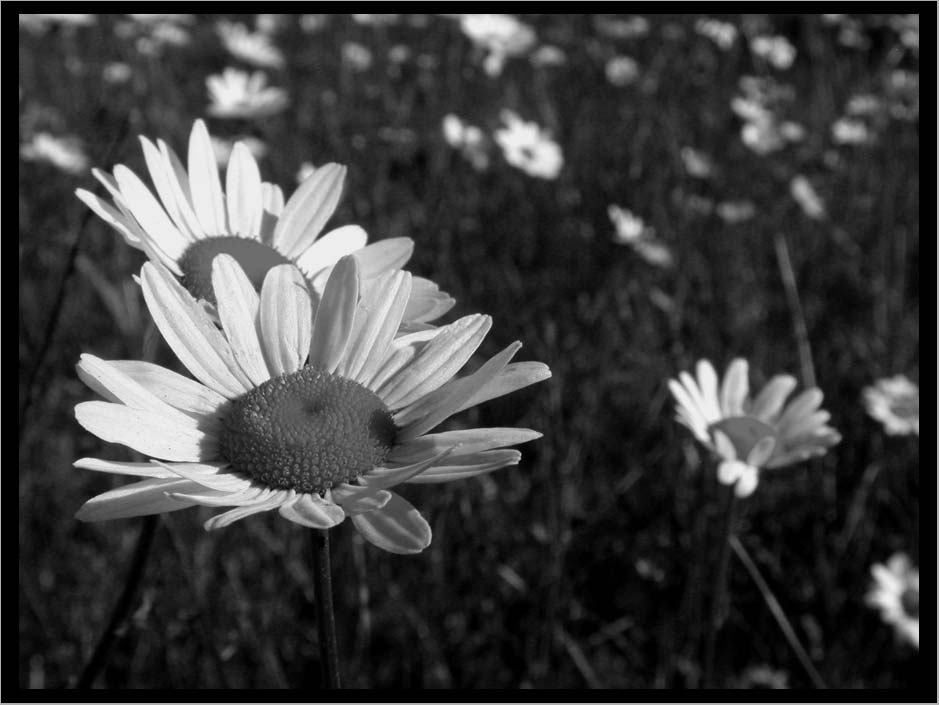

Oxeye Daisies, from Old English, dæges ēage—day's eye—because daisies open in the morning
and close at night (Leucanthemum vulgare)—in a weedy meadow at 1420 m., [click photo for next . . . ]
South Wallowas


Oxeye Daisies, from Old English, dæges ēage—day's eye—because daisies open in the morning
and close at night (Leucanthemum vulgare)—in a weedy meadow at 1420 m., [click photo for next . . . ]
South Wallowas
In North America, the Oxeye Daisy—I call them Goethe's Daisies—
is an import from Europe and considered a weed. I know them
from their native habitat in the Alps in high meadows, where
they are seen as a sure sign of handcutting and little
fertilizer.
The photo here shows
Oxeye Daisies in situ,
in their native habitat in
the Alps. (1300 m.)
In German, this is called a
'thin' meadow. Meaningg it
receives little manure and
is cut entirely by hand with
a scythe.
The species diversity is
anything but thin. (>100 species)
And one could almost make
tea from the hay!
My whole life centers and turns around flowers, and it must
that this flower itself presents us with a beautifully clear
center of centers. Perhaps this is why the Daisy makes its
appearance in classical Poetry on many different occasions.
I'm thinking of Shakespeare's Love's Labour's Lost (1598), with
its "Song of Spring" with which the play ends:
"When daisies pied and violets blue
And lady-smocks all silver white
And cuckoo-buds of yellow hue
Do paint the meadows with delight
The cuckoo then, on every tree,
Mocks married men".
Goethe (1749-1832), who was a gifted observer of Nature and
went on to pen a highly original book on the generation of form
in plants, gave a daisy to Margueriet so that she could determine
Faust's love for her. This is the origin of the famous
plucking of the white ray florets—in this composite, mostly
female, by the way—one by one while reciting, "He loves me.
He loves me not."
I play with this theme in two of the pieces below:
CHEAP IMITATION
In the Arts, technique without creativity is like making love
without real passion. The outer movements may look exactly
the same, but we always sense that some central essential
something is somehow utterly absent.
BY THE LIGHT OF A HARVEST MOONShe loves me. She loves me not.
She loves me not?
O gray day! Descending mist mixed with cold rain!
Grief turns to emptiness turns
to walking steeply up the side of an ice mountain.
Crossing the pass,
the past shuts like a door of a hut
you burn to the ground before leaving it in disgust for good.
O distance! O joy forgotten!
not of ending loss,
of ending pain,
but of bumping the head against the sharp-edged ridgeline
of what I thought—what I thought
I knew, for sure.
GOETHE'S DAISY
She loves me. She loves me not.
She loves me?
Yes. I count the rays
moving from center to center,
moving from bright morning Sun,
to pure white petals, to round happy yellow
button of the oh-so-meager dryland daisy.
The eye that sees closes the triangle,
of centers, of rays,
of the love that is sure to be.
I count the rays.
I count the ways
of Sun, of flower,
of the paths that led me
to this lovely morning meadow.
Was it chance?
Was it necessity?
Yes. I count the rays.
I count the ways.
TO KNOW THE MOUNTAINTo know the mountain,
go to the mountain.
To know yourself,
go to the mountain
and climb the mountain.
To protect the mountain,
go to the mountain
to know yourself,
and climb the mountain.
VII.16.2010 Thompson Meadow
Featured gallery, 100 MINIATURES, a set of 100 black & white photographs. ONE image. ONE idea. ONE new way of looking . . .100 MINIATURES—online gallery
Each miniature is a kind of meditation on one idea & one image;
Each lasts 30 seconds; They play in random order;
The music is my BOREA Mix,
for hand-played ePecussion Orchestra.
[ mouse over for controls / lower right fro full-screen ]
